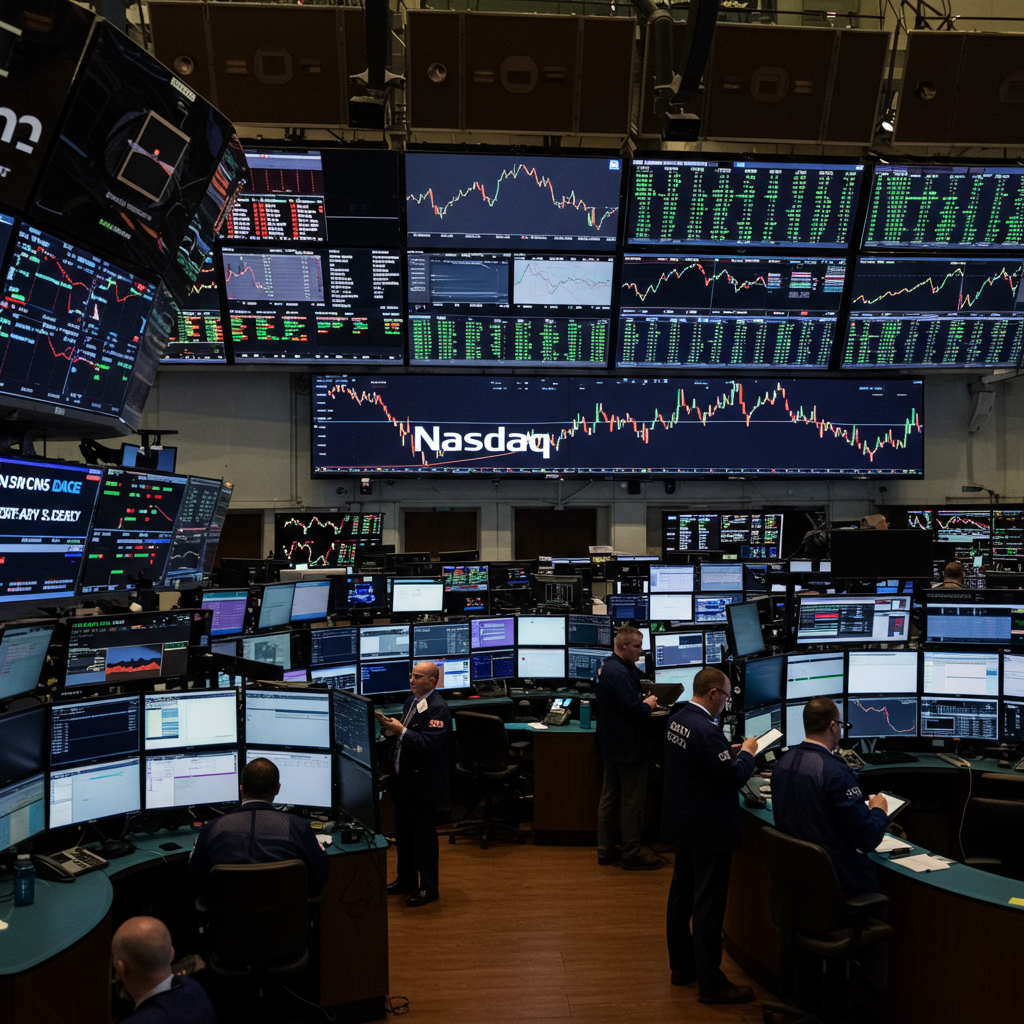US stock markets climbed on a specific Wednesday, with the tech-heavy Nasdaq Composite leading the gains. This positive movement followed a blend of factors: optimism surrounding a new US trade agreement and fresh evidence pointing to a weakening labor market. Investors interpreted these developments as potentially increasing the likelihood of the Federal Reserve cutting interest rates sooner rather than later, fueling a broader market rally. This day’s performance stood in contrast to other periods where trade tensions have weighed heavily on stocks, illustrating how investor sentiment pivots rapidly based on incoming news.
Market Indexes React to policy & Data
On this particular day, the Dow Jones Industrial Average saw a modest gain of approximately 0.1%. The S&P 500, a benchmark for large US companies, advanced by about 0.3%. The Nasdaq Composite, known for its concentration of technology stocks, notably outperformed, rising around 0.7%. These upward moves demonstrated renewed investor confidence, at least temporarily. The market’s reaction highlighted the sensitivity of stock prices to both international trade policy shifts and domestic economic indicators, especially those influencing the Federal Reserve’s monetary policy decisions.
The Vietnam Trade Deal’s Impact
A significant boost to market sentiment came from President Trump’s announcement of a trade deal with Vietnam. This news ignited hopes among investors that additional trade agreements could be reached, particularly ahead of a previously discussed July 9 deadline for a pause on reciprocal tariffs. The specifics of the Vietnam deal outlined by Trump included Vietnam agreeing to pay a 20% tariff on most goods shipped to the US and a 40% tariff on goods transshipped (routed through Vietnam from another origin country). In exchange, Vietnam granted the US “TOTAL ACCESS” to its markets for trade. Trump suggested this market access could specifically benefit exporters of large engine vehicles like SUVs. News of the deal initially seemed positive for footwear stocks like Nike, On Holding, Deckers, and Lululemon, although their initial gains somewhat tempered as market participants absorbed the details of the tariff structure. This event contrasted sharply with other periods, such as in March 2025, when renewed Trump tariff threats, like doubling duties on Canadian metals, triggered significant market losses and volatility across major indexes. Similarly, even in May 2025, lingering trade uncertainty with China and Trump’s refusal to lower existing tariffs added a layer of caution despite other positive market drivers.
Weak Jobs Report Boosts Rate Cut Hopes
Adding to the day’s positive market momentum was the release of new labor market data. A report from ADP indicated that private employers in the US unexpectedly cut 33,000 jobs in June. This figure fell significantly short of economists’ expectations, which had anticipated the addition of around 98,000 jobs. It marked the first time the private sector had experienced job losses in over two years. While typically seen as negative economic news, in the context of potential monetary policy shifts, weak jobs data can be a positive signal for equity markets. The reasoning is that a cooling labor market provides the Federal Reserve with greater justification to lower interest rates. Expectations for a Fed rate cut increased following this data release. According to CME data from that period, while most observers did not expect a rate cut in the immediate July meeting, nearly all were betting on at least one cut by September. Furthermore, over 20% of those tracking Fed policy were pricing in the possibility of two rate cuts by September, underscoring the market’s focus on dovish monetary policy action. This contrasts with other labor data points, like the January 2025 JOLTS report showing slightly more job openings, which painted a different picture of the employment landscape.
Broader Market Movers & Sector Focus
Beyond the major indexes, several individual stocks influenced the day’s performance. Apple (AAPL) shares saw a rise after receiving an analyst upgrade, contributing to the Nasdaq’s strength. Tesla (TSLA) also climbed following its report of higher-than-expected vehicle production numbers in the second quarter, despite facing a reported drop in sales during the same period. However, not all sectors benefited. News regarding President Trump’s “One Big Beautiful Bill,” which includes provisions for slashing federal health spending, negatively impacted insurance stocks across the board on that day. Companies like UnitedHealth, CVS Health (parent of Aetna), Cigna, and Elevance Health experienced declines as the bill moved towards a potential House vote after narrowly passing the Senate. The bill’s fate remained uncertain due to internal political divisions, but its potential impact on insurance companies was clear, with estimates suggesting it could leave millions without insurance by 2034. This specific sector reaction highlights how policy debates in Washington can directly influence market segments. Other market events, such as airline stocks plummeting on other dates due to weakening demand or a broader tech sell-off impacting major names beyond the traditional “Magnificent Seven,” demonstrate the varied sensitivities of different market segments to economic news and political developments.
Strategist Perspectives and Market Sentiment
Market observers offered their takes on the day’s events. Strategists noted that the combination of trade optimism and jobs data bolstered the case for lower interest rates, driving the equity rally. Tom Essaye of Sevens Report Research, commenting on similar trade-related market moves on a different date (April 2025 tariff pause), called such policy pivots “incremental positive,” primarily for removing downside risk. Nicholas Colas of DataTrek Research, also reflecting on a previous relief rally, highlighted that markets were “deeply oversold” and volatility indicators like the VIX were at “crisis levels” before positive trade news shifted sentiment dramatically. While the VIX’s specific movement on the day of the Vietnam deal wasn’t detailed, its behavior on days of high uncertainty (like spiking before the April 2025 tariff pause) underscores its role as a market fear gauge. Economists at Goldman Sachs, on a separate occasion (April 2025), even revised down their recession probability forecasts after a positive trade development, illustrating the perceived link between trade policy and economic outlook among experts. However, strategist sentiment can also turn cautious, as seen in March 2025, when firms like Citigroup and HSBC downgraded their views on US equities due to tariff uncertainty and cooling growth forecasts, favoring other global markets instead. This dynamic shows the constant re-evaluation by experts based on incoming data and policy signals.
Interplay of Trade, Fed, and Economy
The market’s reaction on this Wednesday, driven by the Vietnam trade deal and weak jobs data, exemplifies the complex interplay between trade policy, economic indicators, investor expectations for monetary policy, and overall market sentiment. President Trump’s administration’s approach to trade, sometimes involving threats of new tariffs and at other times announcing deals, has been a recurring source of market volatility and a key factor for investors to monitor. Simultaneously, the health of the US labor market, along with other economic data like inflation reports (such as the CPI and PPI reports anticipated on other occasions), serves as crucial inputs for the Federal Reserve. The Fed’s stance on interest rates, whether holding steady or signaling potential cuts, has a profound impact on borrowing costs, corporate profitability, and asset valuations. As Fed Chair Jerome Powell noted during a May 2025 press conference, the economic outlook can be “extremely elevated” with uncertainty, and the central bank adopts a “wait and see” approach, allowing data to guide policy decisions. While the Fed’s tools are primarily geared towards managing demand, Powell acknowledged that supply-side issues, including the effects of tariffs, also contribute to the economic picture. The market’s behavior on this specific day underscores that positive developments on trade paired with data supporting a more dovish Fed outlook can swiftly boost investor confidence and propel indexes higher, even amidst broader or ongoing economic uncertainties.
Frequently Asked Questions
What were the main reasons US stock indexes rose on this specific day?
US stock indexes, particularly the Nasdaq Composite, climbed due to two primary factors reported on that day. First, President Trump announced a trade deal with Vietnam, which boosted optimism for further progress on trade relations and reduced immediate tariff concerns. Second, weak US private jobs data for June was released, showing an unexpected cut in employment. This weak data increased investor expectations that the Federal Reserve might be more likely to cut interest rates soon.
How did the Vietnam trade deal impact investor sentiment?
The announcement of the Vietnam trade deal was largely seen as positive news by investors. It signaled potential progress in US trade policy and reduced uncertainty regarding tariffs, especially with a key deadline approaching. The deal, which involved Vietnam accepting certain tariffs in exchange for market access for US goods, was interpreted as a constructive step that lifted market spirits and supported a risk-on environment in equities.
Why did weak jobs data lead to market gains instead of losses?
Weak jobs data often signals a slowing economy, which would typically be seen negatively. However, in a market context where investors are focused on potential interest rate cuts from the Federal Reserve, weak economic data like job losses can be perceived positively. It provides the Federal Reserve with a stronger economic argument to ease monetary policy by lowering rates, which makes borrowing cheaper, can stimulate economic activity, and often supports higher stock valuations.
Conclusion
On a notable Wednesday, US stock indexes experienced solid gains, led by the Nasdaq, demonstrating the market’s responsiveness to a combination of positive trade news and economic data that signaled potential monetary policy shifts. The announcement of a trade deal with Vietnam provided a tailwind of optimism regarding international commerce, while unexpectedly weak private jobs data fueled hopes for imminent interest rate cuts by the Federal Reserve. This day served as a clear example of how investor sentiment and market direction are shaped by the interplay of trade policy developments and key economic indicators, illustrating the nuanced factors that financial market participants constantly monitor and react to.




